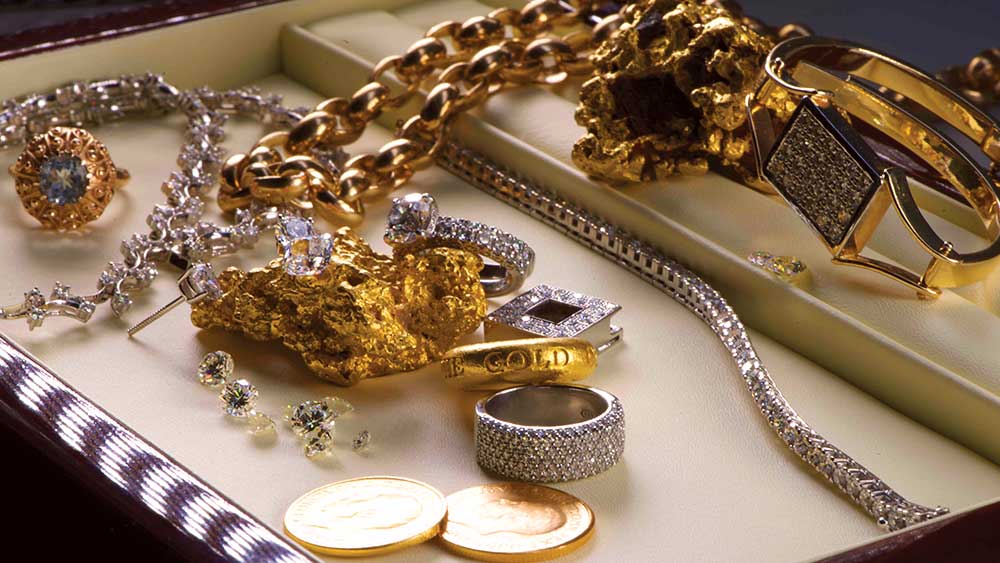Goldpedia

8 karat or 8K gold, aka 8 carat or 8ct gold
The stamp “8K” or “333” means that the gold in the article weighs 8/24, or 33.3%, of the total weight of the item. The remaining weight of the gold item consists of other metals mixed with the gold, such as nickel, zinc, copper, or silver.
9K Gold
The stamp “9K” or “375” means that the gold in the article weighs 9/24, or 37.5%, of the total weight of the item. The remaining weight of the gold item consists of other metals mixed with the gold, such as nickel, zinc, copper, or silver.
Alloy
An alloy is a mixture of two or more metals made by melting them together. For example, gold is alloyed (combined) with metals such as silver, copper, zinc, rhodium, and nickel to change certain characteristics such as colour and hardness. Platinum alloys are usually made by combining platinum with ruthenium, iridium, palladium, cobalt, or copper.
Applique gold
Applique gold is one colour of gold soldered onto another.
Assay
A gold assay is a test to ascertain the fineness and weight of gold. There are a number of assay tests to determine gold content. To learn more about gold testing, please see How Gold Buyers Test Gold & Platinum.
Bar
Gold bars are blocks of refined gold that come in a variety of shapes, weights, and purities. Different gold bars are favoured in different parts of the world, but buying gold bars and selling gold bars is easy as gold bars are highly liquid.
Base Metal
A base metal is any non-precious metal. Examples of base metals include copper, steel, aluminium, and brass.
BU
BU is an abbreviation for “brilliant uncirculated”, which is a term often used to describe a gold coin in new condition.
Bullion Coin
A gold bullion coin is a legal tender coin whose market price is determined by its gold content, rather than its rarity or face value.
Double d’Or
Double d’or items have a thin layer of 10K or better-quality gold mechanically bonded with heat and pressure to all significant surfaces. This layer of gold must be at least 1/20 of the total metal weight, which is 50 to 100,000 times thicker than the layer of gold on gold plated jewellery. The typical quality mark on gold overlay items is 1/40 12K RGP. Gold overlay items are also know as gold filled and gold overlay.
Electronic Gold Tester
The electronic gold tester (commonly referred to as the ‘gold pen’) is a cheap, although portable gold testing technique based on the capacitance decay principle. Accuracy is poor, being correct to only 1-2 karats (4-8%) and is compromised if the gold surface is gold-plated, for example. It is useful only as a sorting test for gold.
Fineness
Gold fineness is also known as gold purity, usually expressed in parts per thousand. For example, a gold fineness of 916 contains 916/1000 or 91.6% pure gold and 84/1000 or 8.4% other metals alloyed with the gold. Current technology applications now make it possible to produce gold of up to 99.9999% purity.
Gold Filled
Gold filled items have a very thin layer of 10K or better-quality gold mechanically bonded to all significant surfaces. This layer of gold must be at least 1/20 of the total metal weight. The typical quality mark on gold filled items is 1/40 12K RGP. Gold filled items are also know as gold overlay and double d’or.>
Gold Standard
A gold standard is a monetary system based on convertibility into gold, where paper money is backed and interchangeable with gold bullion.
Goldwork
Goldwork is any work produced by a goldsmith.
Koala
A Koala is an Australian platinum coin that is 99.5% pure platinum.
Kruggerand
A Krugerrand is a 22K South African gold coin weighing exactly 1 troy ounce, equal to 33.93 grams. Krugerrands are 91.67% pure gold, alloyed with 8.33% copper to increase their hardness and durability. Krugerrands are trademarked and produced by a company called Rand Refinery Limited in South Africa.
Mint Mark
A gold mint mark is a letter or symbol stamped on a gold coin to identify the minting facility where it was struck.
Platinum Group Metals (PGM)
Platinum and the five (5) other metals which are chemically and physically similar and which are often deposited with it: palladium, iridium, osmium, rhodium, and ruthenium.
PT
PT is the chemical symbol for platinum. “PT” and “PLAT” are used as abbreviated marks for platinum when identifying the metal and fineness of platinum. For example, when “950 PT” or “950 PLAT” is stamped on a piece of jewellery, it means that it contains at least 950 parts per 1000 (95%) of pure platinum.
Quality Mark
A gold quality mark is a set of numbers, letters, or symbols stamped on metal to indicate its type (ie. gold, silver, platinum, etc) and content. For example, metal stamped “18K” is 75% gold, while metal stamped “PLAT950” is 95% platinum. Fineness and karat marks are quality marks.



0 Comments